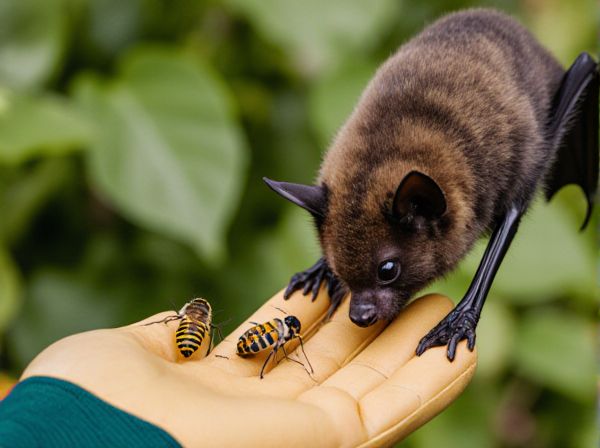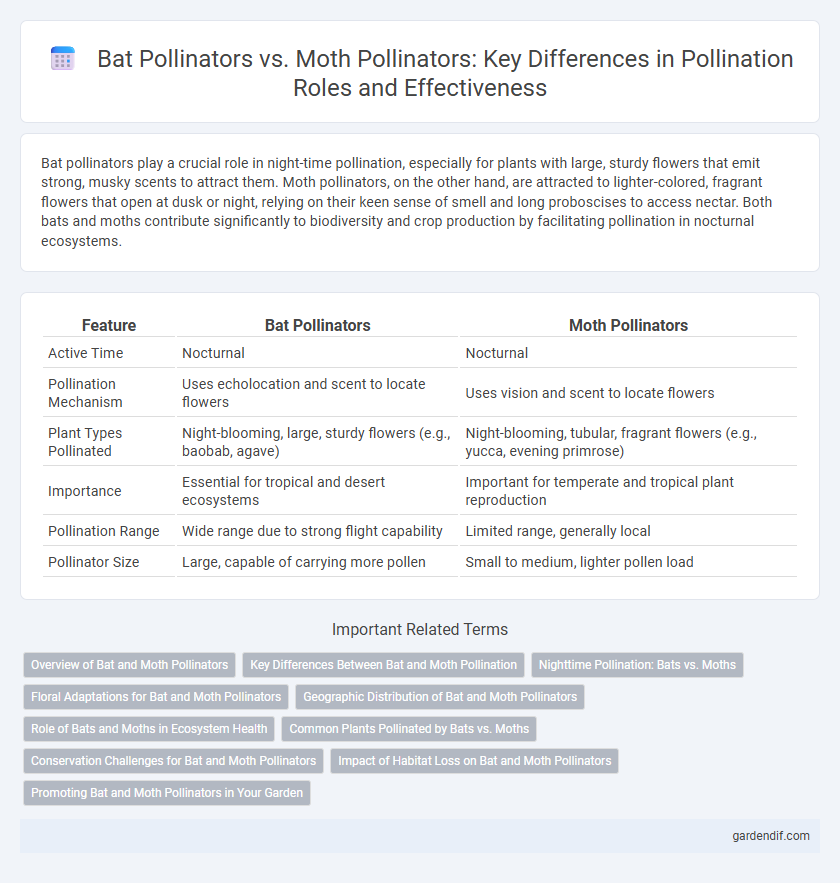
Bat pollinators vs Moth pollinators Illustration
Bat pollinators play a crucial role in night-time pollination, especially for plants with large, sturdy flowers that emit strong, musky scents to attract them. Moth pollinators, on the other hand, are attracted to lighter-colored, fragrant flowers that open at dusk or night, relying on their keen sense of smell and long proboscises to access nectar. Both bats and moths contribute significantly to biodiversity and crop production by facilitating pollination in nocturnal ecosystems.
Table of Comparison
| Feature | Bat Pollinators | Moth Pollinators |
|---|---|---|
| Active Time | Nocturnal | Nocturnal |
| Pollination Mechanism | Uses echolocation and scent to locate flowers | Uses vision and scent to locate flowers |
| Plant Types Pollinated | Night-blooming, large, sturdy flowers (e.g., baobab, agave) | Night-blooming, tubular, fragrant flowers (e.g., yucca, evening primrose) |
| Importance | Essential for tropical and desert ecosystems | Important for temperate and tropical plant reproduction |
| Pollination Range | Wide range due to strong flight capability | Limited range, generally local |
| Pollinator Size | Large, capable of carrying more pollen | Small to medium, lighter pollen load |
Overview of Bat and Moth Pollinators
Bat pollinators, primarily nectar-feeding species like the lesser long-nosed bat, play a crucial role in pollinating nocturnal flowers with robust structures and strong scents, especially in tropical and desert ecosystems. Moth pollinators, such as hawk moths, are adapted to visiting flowers with deep corolla tubes, relying on their long proboscises and sensitivity to pale or white blossoms that are fragrant at night. Both bats and moths contribute significantly to the reproduction of diverse plant species, supporting ecosystem health and biodiversity through their specialized pollination behaviors.
Key Differences Between Bat and Moth Pollination
Bat pollinators typically operate at night and are attracted to large, white or pale-colored flowers with strong fruity or musky scents, while moth pollinators prefer smaller, pale, tubular flowers emitting sweet fragrances. Bats transfer pollen through their fur as they feed on nectar, enabling pollination of larger, more robust flowers; moths use their long proboscises to access nectar from narrow floral tubes, favoring delicate blossoms. The differing sensory cues and feeding behaviors between bat and moth pollinators influence floral adaptations and ecosystem pollination dynamics.
Nighttime Pollination: Bats vs. Moths
Bat pollinators, primarily nectar-feeding species such as the lesser long-nosed bat, are crucial for nighttime pollination of large, robust flowers with strong scents, often found in cacti and agave plants. Moth pollinators, especially hawk moths, specialize in visiting tubular, pale-colored flowers with sweet fragrances that open at night, enabling efficient nectar extraction with their long proboscises. Both bats and moths enhance nocturnal pollination but target distinct floral traits, ensuring diverse plant reproductive success in nighttime ecosystems.
Floral Adaptations for Bat and Moth Pollinators
Bat-pollinated flowers typically exhibit large, pale-colored, and sturdy structures with strong scents emitted at night, supporting nocturnal bat feeding habits through abundant nectar production and ample space for echolocation detection. Moth-pollinated flowers tend to be tubular, white or pale, releasing sweet fragrances at dusk or night, with narrow openings suited to moths' long proboscises for efficient nectar extraction. Both floral adaptations enhance reproductive success by maximizing attraction and accessibility for their respective pollinator groups.
Geographic Distribution of Bat and Moth Pollinators
Bat pollinators primarily inhabit tropical and subtropical regions across Central and South America, Africa, Asia, and Australia, where they play a crucial role in night-time pollination of plants like agave and durian. Moth pollinators exhibit a broader geographic distribution, ranging from temperate to tropical zones worldwide, including Europe, North America, and parts of Asia, facilitating the pollination of various night-blooming flowers such as yucca and hawk moth-attracted blossoms. The overlapping yet distinct habitats of bat and moth pollinators highlight their complementary roles in maintaining diverse ecosystems across global biomes.
Role of Bats and Moths in Ecosystem Health
Bats serve as nocturnal pollinators for over 500 plant species, including key agricultural crops like bananas and agave, facilitating genetic diversity and ecosystem resilience. Moths contribute significantly to pollination by visiting a wide variety of night-blooming flowers, supporting biodiversity and plant reproduction in many terrestrial ecosystems. Both bats and moths enable healthy habitats by sustaining plant populations that provide food and shelter for numerous wildlife species.
Common Plants Pollinated by Bats vs. Moths
Bat pollinators primarily feed on nectar from plants like agave, baobab, and durian, which often exhibit large, fragrant, nocturnal flowers adapted for bat visitation. Moth pollinators favor plants such as yucca, evening primrose, and jasmine, characterized by pale-colored, tubular flowers that emit strong scents at night to attract moths. Both pollinators play crucial roles in the reproductive cycles of these specific plant species, ensuring genetic diversity and ecosystem health.
Conservation Challenges for Bat and Moth Pollinators
Bat pollinators face conservation challenges due to habitat loss, white-nose syndrome, and human disturbances disrupting their roosting sites, while moth pollinators struggle with light pollution, pesticide exposure, and habitat fragmentation reducing their populations. Both bat and moth pollinators are crucial for ecosystem services and biodiversity, yet their nocturnal activity makes monitoring and protection efforts more complex. Conservation strategies must address species-specific threats and promote habitat connectivity to sustain pollination networks vital for many plant species.
Impact of Habitat Loss on Bat and Moth Pollinators
Habitat loss severely threatens bat and moth pollinators by reducing the availability of their native floral resources and roosting sites, leading to population declines. Bats, which often rely on large, undisturbed caves and forested corridors, experience more pronounced disruptions in reproductive success and foraging efficiency. Moth pollinators, dependent on specific host plants and night-blooming flowers, face fragmentation that limits their dispersal and genetic diversity, exacerbating their vulnerability to environmental changes.
Promoting Bat and Moth Pollinators in Your Garden
Promoting bat pollinators in your garden enhances nocturnal pollination by attracting species such as the lesser long-nosed bat, which effectively pollinates cacti and agave plants. Moth pollinators, including hawk moths and sphinx moths, contribute to evening pollination of night-blooming flowers like moonflowers and evening primroses. Incorporating native flowering plants that bloom at night, along with providing roosting habitats, supports both bat and moth populations, boosting biodiversity and improving fruit and seed production.
Bat pollinators vs Moth pollinators Infographic

 gardendif.com
gardendif.com